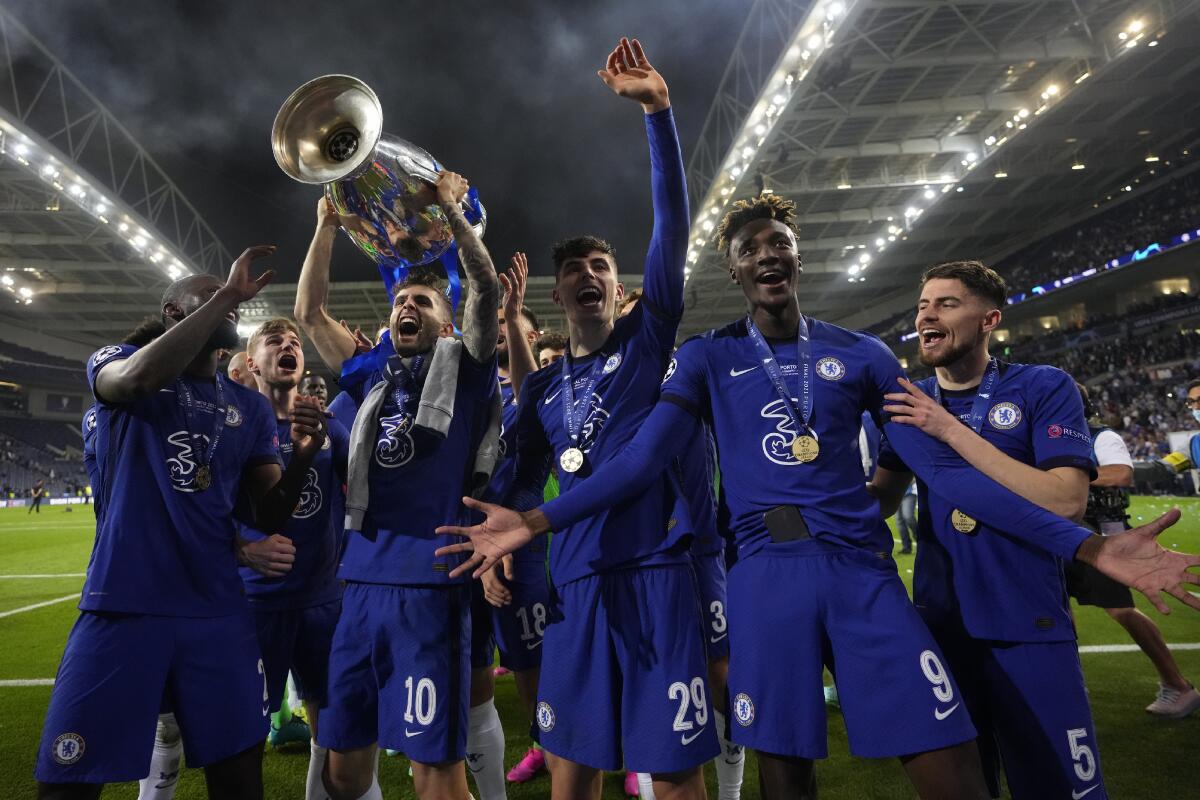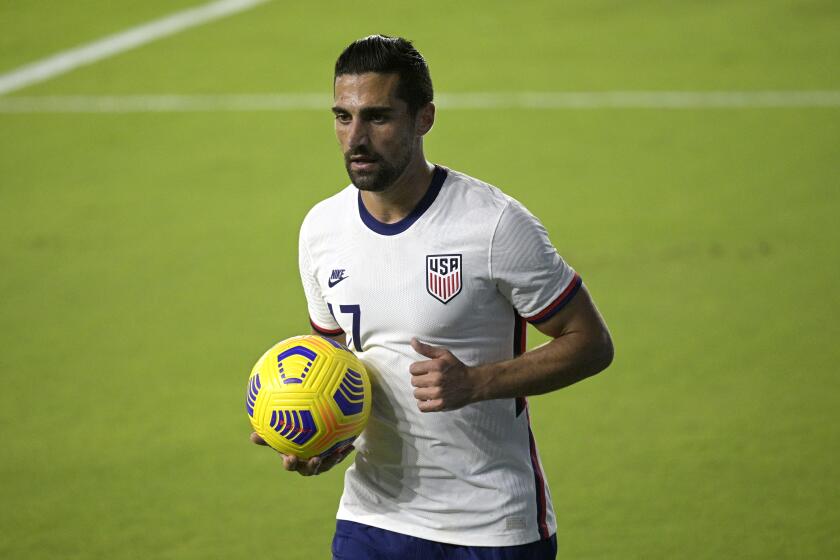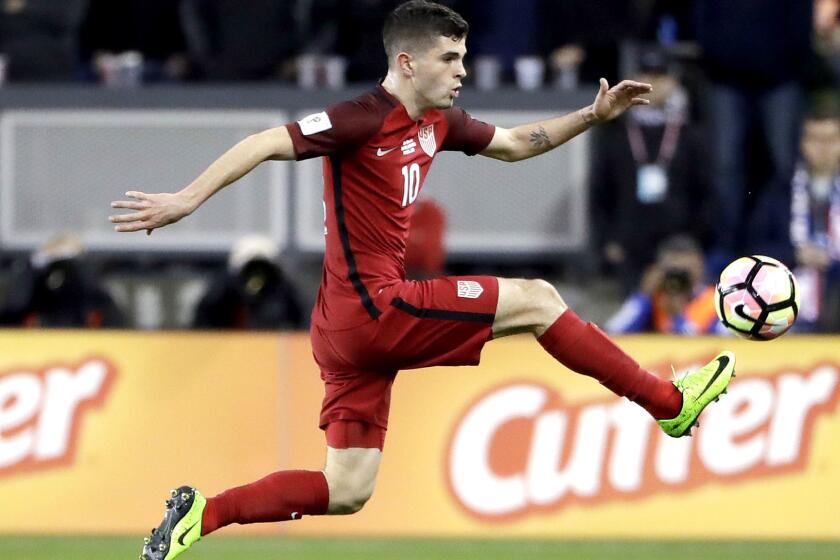What Nations League will tell us about the future of U.S. and Mexico soccer teams

Alexi Lalas knows a turning point when he sees one.
It happened in his first national team start, at the Coliseum against a Mexican team that had lost only one of its previous 26 games against the U.S. But on that day, the 20-year-old Lalas helped the Americans gut out a 2-2 draw, starting a streak that would see them lose just one of eight games with Mexico.
“I was right there in that shift,” Lalas said. “It was kind of the start of that generation that didn’t accept that we should continue to be inferior to Mexico on the field, that we should continue to lose.”
By the time a teen-aged Landon Donovan made his international debut nine years later — also against Mexico at the Coliseum — the pendulum had swung back and the U.S. was inferior once again. Donovan changed that, with his game-winning goal beginning a roll that would see the U.S. go 9-2-2 in its next 13 games with Mexico, its most successful stretch ever in the cross-border rivalry.
The USMNT and El Tri are loaded with young talent that could alter the future of the U.S. and Mexico soccer teams for years to come.
Now another group of young Americans is poised to flip the script anew in this week’s Nations League in Denver. If both teams win their preliminary matches Thursday — the U.S. against Honduras and Mexico over Costa Rica — they will meet for the 71st time in Sunday’s championship game. The U.S. heads into the semifinals with perhaps the deepest and most talented collection of young players in its history. Nineteen of its 23 players are with top-division teams in Europe, where nine of them appeared in at least 30 league games this season. Twelve of those European-based players are under the age of 24.
Meanwhile Mexico, ranked 11th in the world by FIFA, has a roster that includes 12 veterans from the last World Cup in Russia, where it fielded the second-oldest team in the tournament.
If the momentum shifts once more, the change may be a lasting one since the core of the U.S. team could be together for a decade, while Mexico’s aging squad will soon need a makeover.
“This young generation, they come with a swagger and a confidence, an arrogance that they want this moment. It is their time,” Lalas said.
“If I was the Mexican Soccer Federation, that would be cause for concern.”
The two countries have followed different paths to this latest crossroads, paths influenced in large part by their domestic leagues. The deep academy system in Liga MX has made Mexico a world power at the youth national team level, where it has reached the final in three of the last five U-17 World Cups while winning gold in the 2012 Olympics.
“The level of talent showcased on [the] U-17s, U-20s is second to none. It’s probably one of the four, eight [top] programs on the youth level in the world,” said Galaxy general manager Dennis te Kloese, who was director of Mexico’s youth national teams for several years before taking over the entire national team program ahead of the 2018 World Cup. “So there’s a lot of talent. That’s not the question.”
Soccer: And he vows he will remember at least one of the boots when they meet again.
Once those players reach a first-team roster in Mexico, however, they can get stuck there, which is why just eight of the 23 players on Mexico’s Nations League team play on the continent, while more than half play in Liga MX.
The exorbitant transfer fees Mexican clubs often ask for their players and the relatively high salaries in Liga MX are two reasons players don’t leave. Another factor slowing the development of young talent is a Liga MX rule that allows teams to carry as many as nine foreign players on match-day rosters. Under pressure from Tata Martino, coach of the Mexican national team, that number will drop to eight next year and to seven in 2022-23.
“In the United States they give an outlet to young players and in Mexico they are more concerned about bringing foreigners than about giving the young players of Mexico an opportunity,” Carlos Hermosillo, whose 35 goals rank fourth all time for Mexico, said in Spanish. “The clubs have to understand that in order to grow our football, we have to generate young players.”
The Mexicans have heard that chatter, which is why so many of their players took delight in their team qualifying for the Olympics — a U-23 tournament — for the third time in four tries while the U.S. did not.
“The young players in Mexico, they’re aware of all the talk around the U.S. [about] the young players playing in Europe,” said Stu Holden, a former U.S. national team player and now an analyst for Fox Sports who covered the Olympic qualifiers. “They have some really good young players that will be on the verge of making those moves to Europe in the next couple of months. Or at least in the next year, year and a half.
June 17 marks the two-year anniversary of Mexico stunning Germany in the 2018 FIFA World Cup. For many fans, this is the most significant victory for El Tri.
“So I don’t think it’s as clear as we’re head and shoulders above them with our next level of talent.”
U.S. players have gotten there first partly because they typically face far fewer hurdles. While the MLS academy system is still growing, it has already helped current national team players such as Weston McKennie, Gio Reyna, Tim Weah and Josh Sargent move to major clubs in Europe without playing a game in MLS. Several others, including Christian Pulisic, Jordan Siebatcheu, Antonee Robinson, Sebastian Lletget, Sergiño Dest, Konrad de la Fuente and Yunus Musah, were developed on the continent.
“These American players don’t depend on Major League Soccer and these Mexican players depend on their domestic league to go abroad. And that’s a huge problem because if the domestic league thinks their product is worth more, there aren’t going to be teams in Europe to take a chance on them,” said Hérculez Gómez, a former U.S. international who played five years in Liga MX. “Your avenues for opportunity are greater on this side than in Mexico.”
It’s not like Mexicans have never played for big clubs. Dozens have, just not now, with only two under-24 players on the Nations League roster — Edson Álvarez and Gerardo Arteaga — playing in Europe. The U.S. has six times as many, which gives it an advantage, said Te Kloese.
“There’s not a lot of science to it. And it goes back to younger players,” he said. “The more players you have at higher competition and in good environments and playing the best against the best, that’s how players get better.
“Obviously that is going to matter. It’s going to make a positive impact on U.S. Soccer’s program. 100% sure.”
Galaxy midfielder Sebastian Lletget is one of four MLS players called up to a European-heavy USMNT roster ahead of the CONCACAF Nations League Final Four.
Yet it was Mexico’s success and the U.S. failure in the last World Cup cycle that led both countries to this latest potential turning point. Mexico won the CONCACAF qualifying tournament, beat defending champion Germany in its World Cup opener in Russia and advanced to the knockout round for a seventh straight time. Brazil is the only other country to have achieved the feat.
And Mexico kept winning, losing just twice in 25 matches since Martino took over as coach in 2019, climbing into the top 10 in the world rankings for the first time in 15 years. As a result, there has been little reason to change course and the inevitable roster overhaul has been delayed, with just five players on the Nations League roster having made their senior international debut since the last World Cup.
“It’s actually kind of a huge dilemma for them right now,” Holden said. “Tata really hasn’t turned the team over yet because no one’s taking those spots.”
Added Claudio Suárez, whose 177 international caps are the most in Mexican history: “My point of view is you have to take the best players you have at the moment. It’s not important if they’re 30-something or 22 or 23. You have to take the best. You have to think about winning, not building a foundation.”
But, he added “it’s incredible that there’s no long-term project … planning for the future.”
When Jozy Altidore joined the U.S. national team as a precocious teenager a decade ago, some of his chores included carrying water bottles to training sessions and picking up equipment afterward.
For the U.S., meanwhile, the failure to qualify for World Cup for the first time in more than three decades led U.S. Soccer to start over, with national team coaches Dave Sarachan and Gregg Berhalter issuing the soccer equivalent of open auditions, giving 64 players their first senior national team caps in the last 3 1/2 years. Fourteen of the 23 players on the Nations League roster made their senior international debuts during that period.
“The lowest point in U.S. Soccer history was not qualifying for the World Cup,” Lalas said. “And yet we find ourselves in possibly the most positive and bullish moment in our history, given not just the talent that we have, but the depth of the talent. It remains to be seen whether it’s going to live up to the expectations that we have.”
That question will be answered in the crucible of CONCACAF competition, including Nations League and this fall’s World Cup qualifiers. Because while the players on the U.S. roster have a combined 80 games of experience in the Champions League, just seven of them have appeared in a World Cup qualifier.
And the two competitions couldn’t be more different.
“The only way you can get comfortable in that environment is experience with it,” said Donovan, who played in 40 World Cup qualifiers, behind only Clint Dempsey and Jozy Altidore among Americans. “There’s no simulation for going to Barbados, on a tiny little island, playing on a horrible field, 95-degree weather with 90% humidity other than doing it and feeling the pressure involved.
“We don’t have enough guys right now who have been through enough of those experiences.”
Mexico does. And if this young American team can’t adapt to those challenges, it won’t matter how many of them play in Europe or how many Champions League games they win.











